Apr 11, 2025

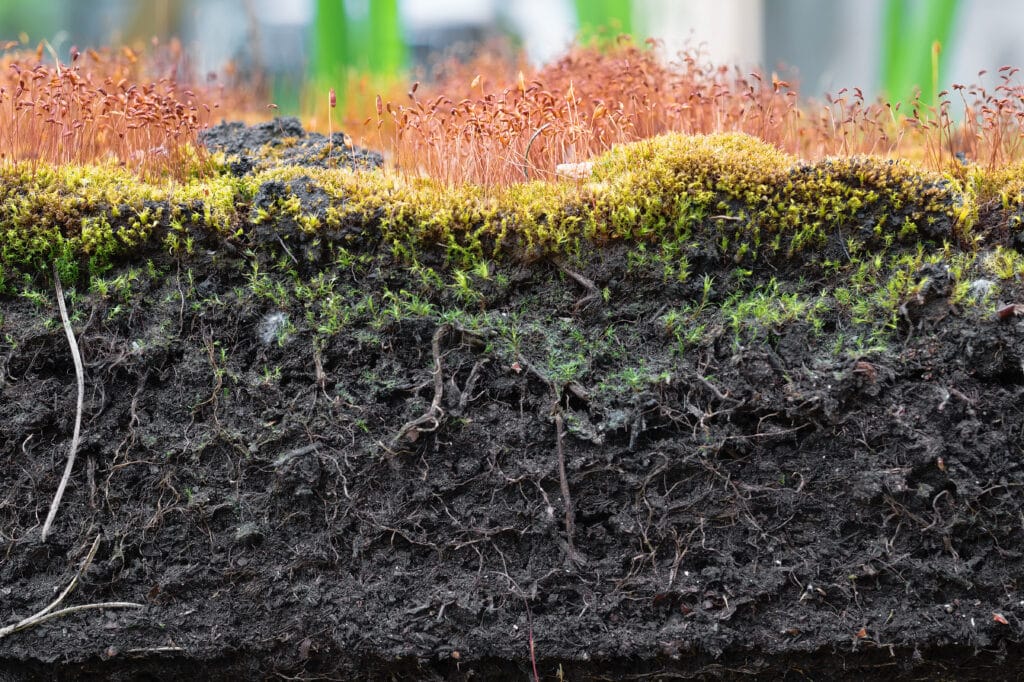
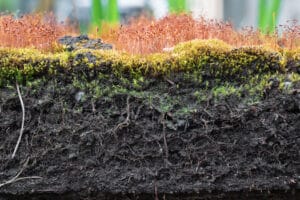
Your soil is the foundation of your farm. You wouldn’t build your home on a structure that couldn’t hold your house. So, why would you try and grow crops in soil structure that could diminish your yield potential?
If you have a hunch your soil is suffering from compaction, it may be time to invest in your soil microbes. Beneath the surface of your soil at every stage of the farming process is a microscopic community known as the soil microbiome. These microscopic organisms impact your plants and your soil. They’re essential for creating a strong foundation for your crops to grow from.
By understanding soil structure, and the integral role soil microbes play in creating a healthy soil, growers can support microbes for healthier soil, crops, and yields.
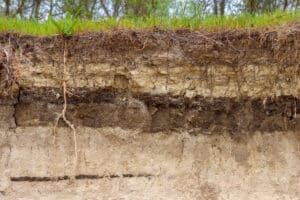
Soil structure is the way sand, clay, silt, and sometimes organic material assemble together. When these particles group together to make larger particles, they are known as aggregates. These aggregates include soil particles and pores in your soil.
Well-structured soil is porous, crumbly, rich in organic matter, and teeming with macro and microscopic life. The shape, size and cohesion of your aggregates impacts how easily air, water, and roots move through the soil – all of which impacts crop health and yield potential.
Grade, class, and type are the three categories used to describe structure. Each refers to a different characteristic or trait of your mineral composition. Combining two or three of these categories can give you a full picture of the health of your aggregates and individual units.
The soil grade is the degree of aggregation, or cohesion and adhesion between aggregates. The grade is measured on a scale of 0 to 3. 0 is the lowest quality, and 3 indicates good structure.
Grade 0: This grade indicates your soil is structureless without any signs of aggregates. Grade 0’s come in two forms.
One is a massive structure, where all the soil combines together to make one giant aggregate without pore space. This is also known as compact soil.
The other is single-grain structure. This means no particles bind together. Think of sitting on a beach and running your fingers through dry sand – this is what grade 0 feels like.
Grade 1: This grade indicates weak structure, with little to no distinction of aggregates. The soil breaks down into little aggregates easily when removed from the ground.
Grade 2: This grade indicates a moderate structure with moderately durable, distinct aggregates. When removed from the ground, the soil breaks down into many distinct aggregates. There are also some broken aggregates and little unaggregated material.
Grade 3: This grade indicates well formed and distinct, durable aggregates. The soil consists of mainly entire aggregates, with few broken aggregates and little to no extra material.
All growers should aspire for grade 2, or grade 3 soil.
The class is the average size of your soil’s aggregates. The descriptions of size include the following.
Each soil class has their own pros and cons and can inform a grower’s practice.
For example, while coarse or very coarse soil may create difficulty for plant roots to grow in, it can have higher water retention. Vice versa, fine or very fine soils may create greater ease of root development, but retain little water.
This classification describes the form or shape of the aggregates. Here are five of the most common aggregate structure types.
Granular or crumb structure: This soil type has a high permeability, with the most pore space of any type. There are small, nearly spherical grains at the soil surface that allow water to circulate easily.
Blocky or subangular blocky structure: This soil type has a moderate permeability. The shape of the aggregates are square or blocky structural units with sharp edges. The larger the blocks, the higher likelihood water will have difficulty penetrating the aggregates.
Prismatic or columnar structure: This soil type has a medium permeability, as water can easily slip between the vertical columns or pillars. These pillars have miniature yet defined cracks which cause separation.
If the columns and pillars don’t have the necessary defined cracks, it can be an indication of excessive levels of sodium, and lead to poor drainage and circulation.
Platey structure: This soil type has a low permeability, often because the plates or sheets are piled horizontally on top of each other at the soil surface. The overlapping plates greatly impair water movement in the soil.
Massive: This type has a low permeability, because it’s basically one giant aggregate, without pore space for air or water circulation.
The type, class, and grade are all important for understanding your structure.
For example, if your soil is grade 2 soil, but has prismatic or columnar structure, you may need to invest in improving your soil’s structure. Yet, if you have grade 2 soil with a crumb structure, you already have good structure and only need to maintain your soil.
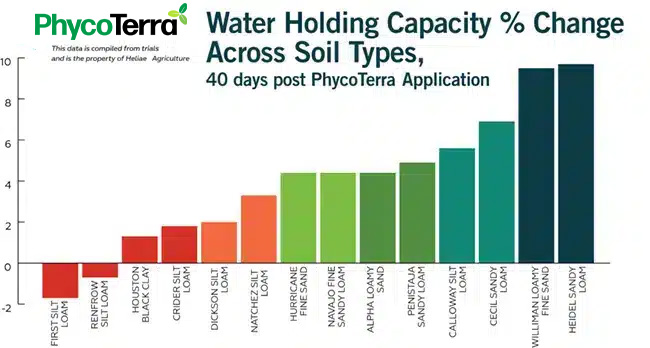
The application of PhycoTerra improves water holding capacity and infiltration significantly, relative to control. A variety of soil compositions and textures respond positively to PhycoTerra whether that be with increased storage (positive chart percentages) or better water infiltration in soils with poor drainage (negative chart percentage). This data is compiled from trials and is the property of Heliae Agriculture.
The structure of your soil greatly impacts your agricultural productivity, including crop health and yield potential. When it comes to crops, your soil structure helps with water, air, and nutrient circulation. If your soil lacks structure for your crop roots to access the things they need to grow, your yield will suffer.
When growers attempt to fix problems associated with degraded soil without targeting the structure it can create a higher annual investment year over year.
For example, soil with great structure often has a healthy and active microbiome. These microbes can create disease-suppressive soil, meaning you can spend less on pesticides, herbicides, and fungicides because pathogens do not have a conducive environment to live in.
While some investment in pesticides, herbicides, or fungicides may be unavoidable, great soil can reduce the need and cost of these inputs, increasing your return on investment.
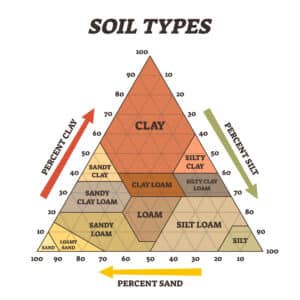
Soil comes in four main types. Yet, some soil types are a mix of two or three types of soil. It depends on the proportions of sand, silt content, and clay content. Your farm soil could be clay. It could also be silt loam. Or, it could be silt clay loam depending on the composition of soil particles.
The main material in your soil is known as the parent material.
Clay soils: Over 25% clay, this type of soil drains slowly due to smaller pore space, and takes longer to warm up in the spring.
Sandy soils: Very little clay with high portions of sand, which allows this type of soil to drain quickly. Often acidic, sandy soils are easily washed out by rain and can be low in plant nutrients.
Silt soils: This type of soil drains well, often includes a medium class, with higher proportions of silt in comparison to sand and clay.
Loamy soils: Like silt, loamy soils are a mix of clay, sand, and silt. They’re normally around 40% silt, 40% sand, and 20% clay. They’re easy to work and have healthy drainage to support crops.
Many growers use a soil textural triangle to determine their type of soil.
|
Soil Type |
Susceptibility to Compaction |
|
Clay |
High |
|
Sandy |
Low |
|
Silt |
High |
|
Loamy |
Medium |
Soil texture is the portion of sand, clay, and silt in your soil.
Soil structure is how particles of soil group together to create aggregates.
Your soil texture may mainly include clay, but the structure greatly impacts your soil’s ability to cycle nutrients, water, and air. High-clay with poor structure is highly susceptible to compaction and can inhibit your crops from getting the nutrients, water, and air they need. High-clay soils with healthy structure can hold water, air, and nutrients easily.
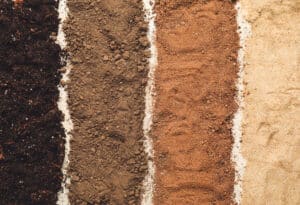
Healthy soil makes it easier for roots to penetrate your soil, increases water circulation, and enables gas exchange. It also helps to mitigate the effects of heavy rainfall by improving water infiltration and reducing runoff.
In times of drought, your soil is also essential for improving water infiltration and retention. Not only are your crop’s roots able to access water when it is available, but your soil will store the water for longer periods of time, reducing the plant’s abiotic stress.
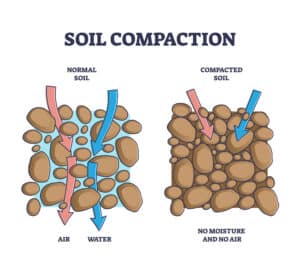
Think about the places on your farm where you regularly drive your machinery. There’s a good chance there aren’t any plants growing in the spots your equipment regularly makes passes through. These areas are compacted soil.
When soil particles are pressed together, the space between them is reduced, causing compaction. Heavy machinery, livestock movement, tillage, or rainfall can all compact soil. When compaction happens, it creates impenetrable aggregates.
Compaction restricts the movement of water, nutrients, and air. The impenetrable wall of soil can lead to surface runoff, causing soil erosion, nutrient loss, and leaching.
When it comes to crops, the lack of aeration can cause roots to suffocate and hinder their uptake of nutrients. This can result in weaker plants and diminished yields.
Without water or air, your soil can become inhospitable to plants, macroorganisms, and microorganisms living in your soil.
In your soil are billions of microbes, including bacteria, fungi, and protozoa. In fact, there are more microbes in one teaspoon of soil than there are humans on earth.
The soil microbiome supports plant growth, reduces abiotic stress, enhances structure, and recycles essential nutrients back to plants. They decompose organic matter, nutrient cycle, suppress diseases, and form aggregates.
Without a healthy microbiome, growers can’t make the most of their fertilizer applications, and may have to invest in fungicides, herbicides, or pesticides to keep pathogens at bay.
Unfortunately, 75% of soil microbes are either dormant or inactive due to starvation. To wake them up, and get them working on creating great soil structure on your farm, feed them a carbon product, like our award winning PhycoTerra.
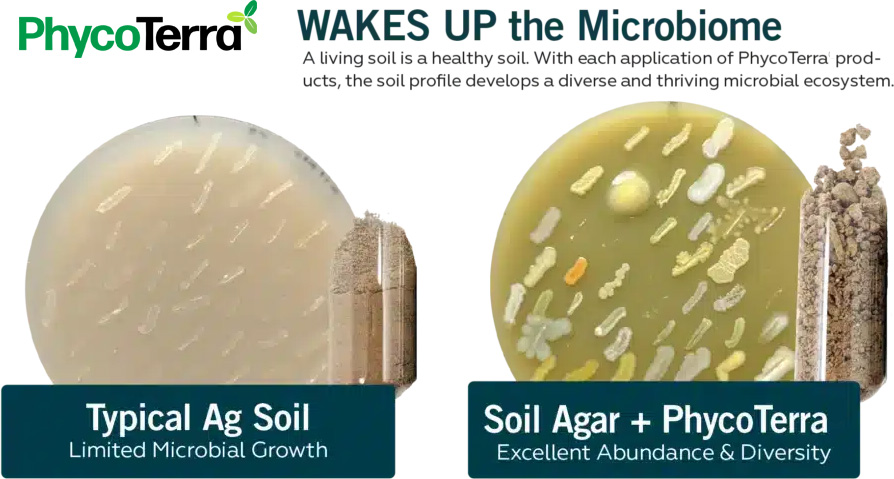
Soil microbes decompose organic material, creating soil aggregates, and by fixing nitrogen for plants. They’re able to do this by creating humus and using fungal hyphae to build aggregates.
Fungi and bacteria create a glue called humus. This glue occurs when soil microbes decompose organic matter, which in turn sticks the particles together, creating aggregates.
Fungal hyphae and fine roots stabilize aggregates. This is why when you pull a plant from your field, clumps of soil will still be clinging to the roots.
Dead plant materials, animal waste, and other organic matter are consumed by microbes and decomposed into simple substances. The decomposition process releases essential nutrients into the soil, making them available for plant uptake.
During the decomposition process, humus is created, which is a stable form of organic matter, or a glue for particles. Humus improves your soil’s structure and increases the soil water-holding capacity, enhancing nutrient retention, and reduces the risk of compaction.
Soil microbes, particularly fungi, contribute significantly to the formation of soil aggregates. Their microbial secretions and fungal hyphae bind particles together.
Mycorrhizal fungi, which form a symbiotic relationship with plant roots, extend their hyphae into the soil. This creates a biological net, binding particles together into aggregates.
Some bacteria, like Rhizobia, can convert atmospheric nitrogen into a form plants can intake. This process, known as nitrogen fixation, is critical for plant growth and productivity especially in crops like legumes.
Nitrogen fixed plants tend to have more robust root systems, which help maintain soil structure and combat compaction.
Certain macroscopic species, like earthworms and burrowing insects, also play an important role in your soil’s structure by creating bio-pores as they move through the soil. These bio-pores increase soil porosity, improve water infiltration, and reduce risk of compaction.
They also provide a channel for roots to penetrate deeper into the soil, enhancing root growth, plant stability, and crop yield potential.
Compaction compresses the air space in your aggregates, and creates an impenetrable wall which makes it difficult or impossible for roots, water, nutrients, and air to penetrate. Compaction occurs during machine passes through the field or when growers use excess tillage. Livestock can also cause compaction, as can heavy rainfall.
Removal of vegetation can also negatively impact your soil. By tearing out living roots, growers disrupt the microbiome and remove precious nutrients soil microbes need to survive. Without roots to help hold soil, wind and water erosion chances also increase.
Excess moving or handling of soil can also deteriorate healthy soil structures. Once you’ve got good soil structure, it’s best to support your soil microbes and let them do the handling of your soil.
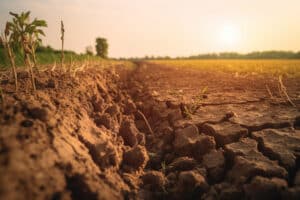
Provide soil cover year around. Investing in a cover crop not only improves your soil structure, it also provides additional nutrients for soil microbes. Given their slow nutrient release rate, your future crops will benefit from the nutrients of last year’s cover crops.
Add organic inputs. When you add organic matter to your soil, your beneficial microbes will break down the matter and create humus – the glue that helps hold aggregates together.
Explore no-till or low-till options on your farm. No one enjoys dealing with post-harvest residue. Instead of tilling the residue, and compacting your aggregates, consider adding a carbon product to your burn down. This will feed soil microbes, who in turn will decompose the post-harvest residue. The residue will then become nutrients for your future crops, and glues to improve your soil structure!
Feed your soil microbes. Much like your crops, soil microbes need to be nourished and cared for. As we mentioned earlier, 75% of all microbes are either dormant or inactive in farm soil due to starvation.
Our award winning carbon-rich product provides your soil microbes with the food they need to flourish. In return, they’ll also enhance soil resilience, support healthier crops, and increase yield potential.
Ready to start the conversation to take your soil from sad to superb? Need some guidance from soil health and structure experts?
Fill out a contact form. We’d be happy to walk you through assessing your soil and making a plan to improve or maintain your soil.